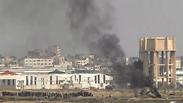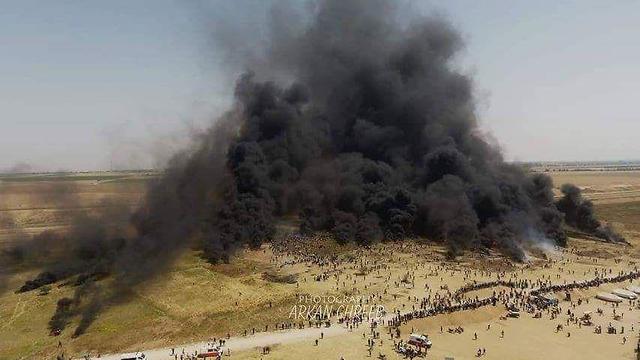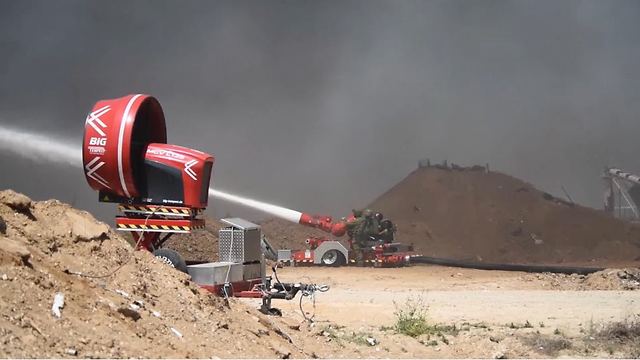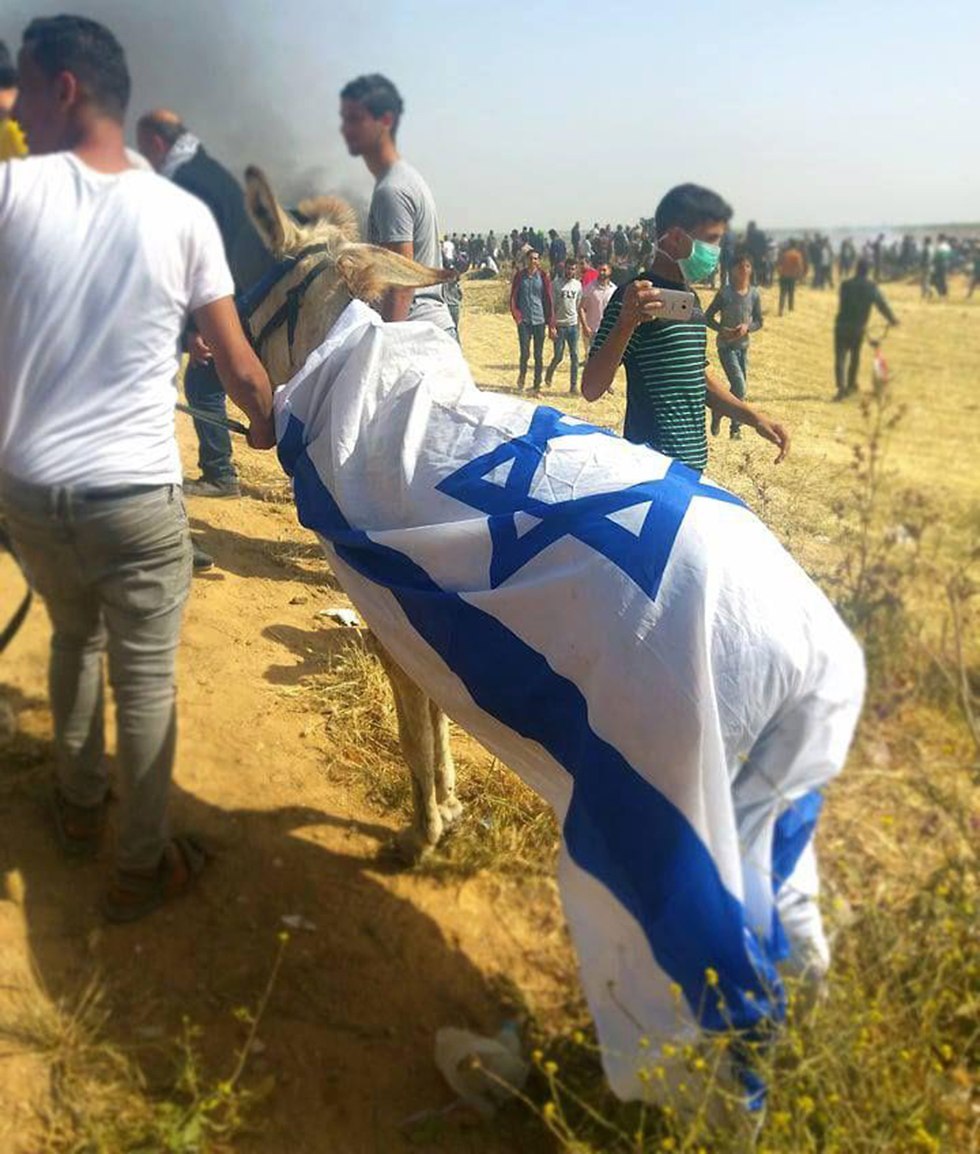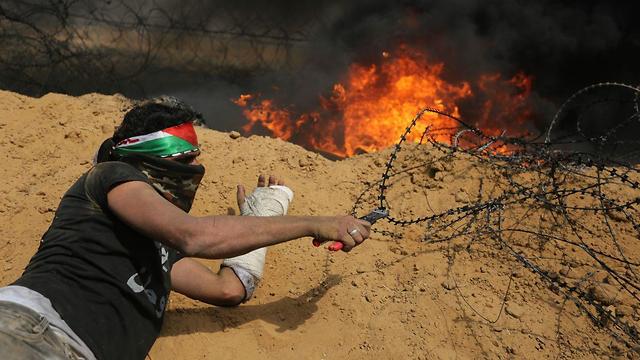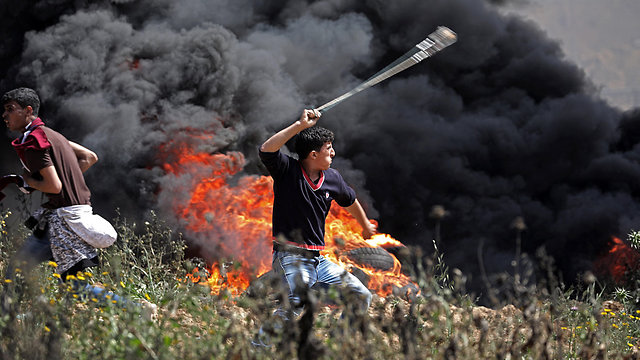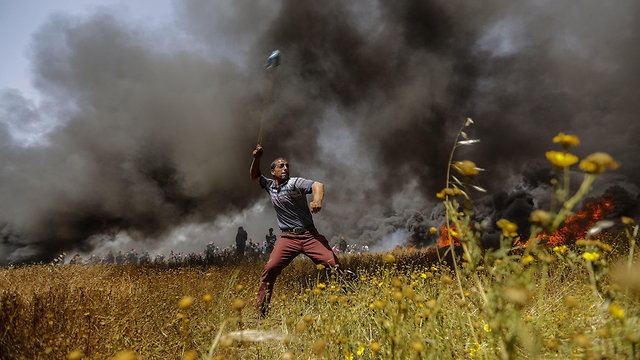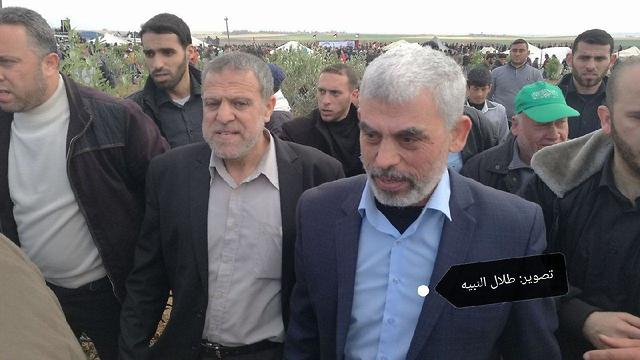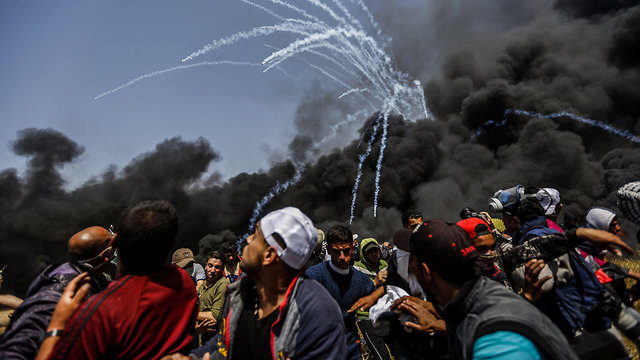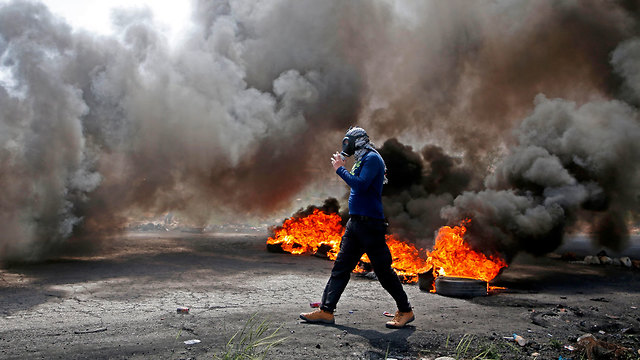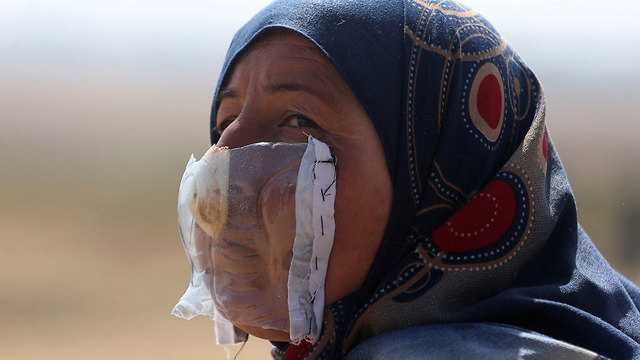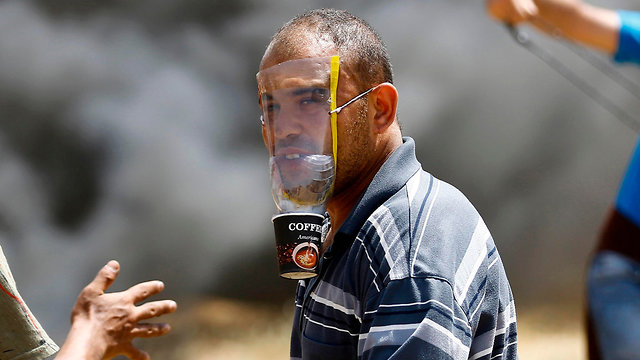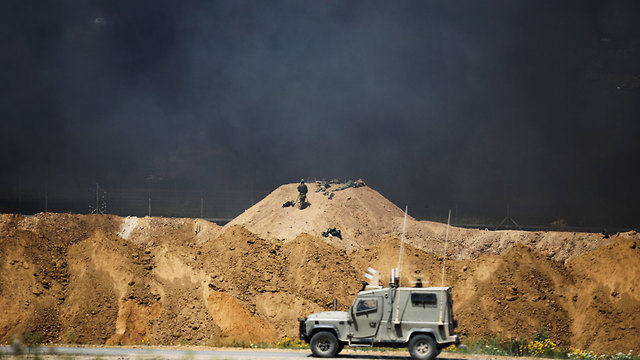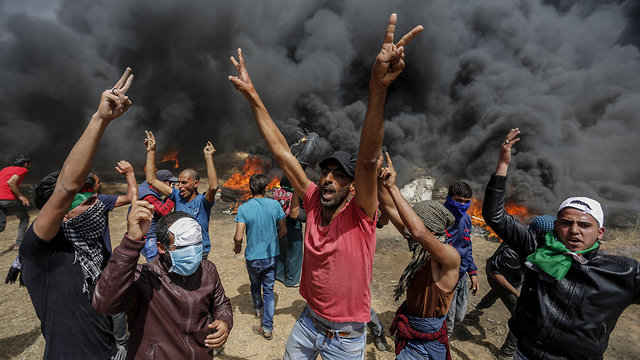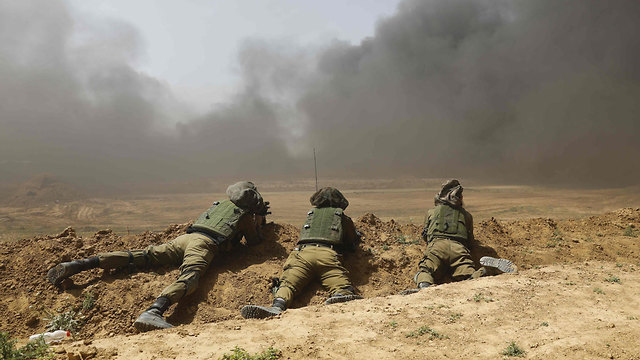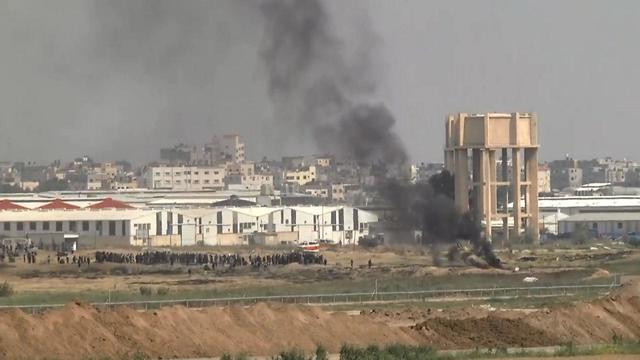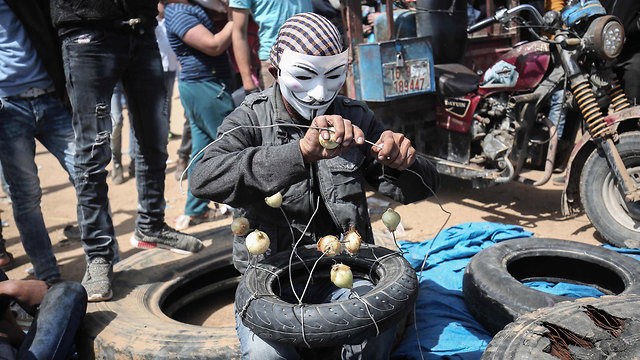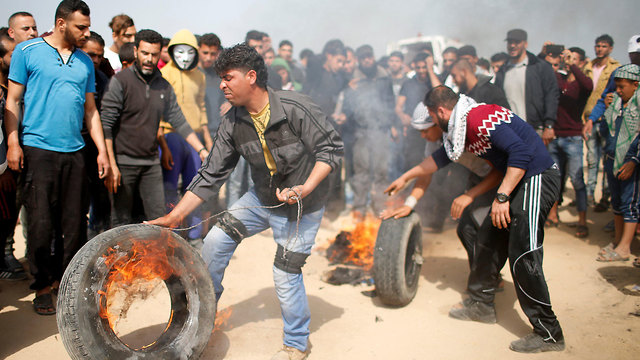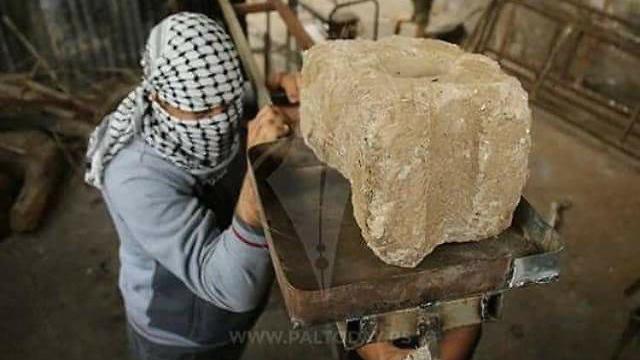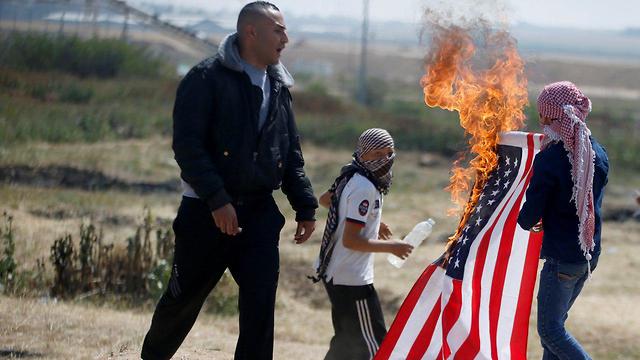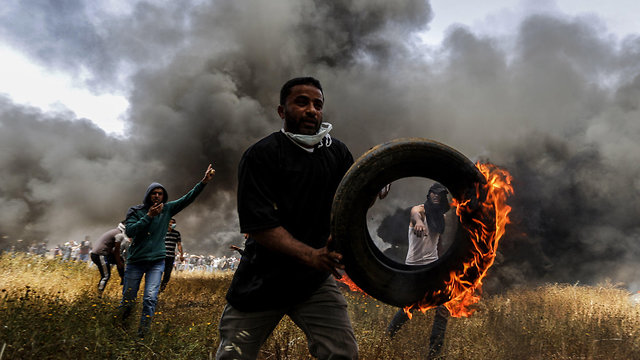
7 Palestinians killed, 5 seriously wounded in 'Friday of Tires' protest
Despite relatively paltry turnout compared to last Friday's inaugural protest, Palestinian protesters near Gaza border begin burning tires in earnest after conclusion of Friday prayers; 7 Palestinians killed, 5 others seriously wounded in clashes with IDF; army thwarts Palestinian attempts to cross, damage fence and throw Molotov cocktails, explosives under cover of smoke.
Precisely a week after last Friday's Land Day protests and mass riots, Hamas's Great March of Return campaign reaches its second apex Friday in what has been dubbed the "Friday of the Tires" with Palestinians burning tires in five points of conflagration along the Gaza Strip border since morning and until nightfall.
Seven Palestinians, including one 16-year-old youth, were killed in clashes with Israeli forces, while five others were seriously wounded, Gaza's Ministry of Health said in a statement. Some 150 more, the ministry said, were hurt by riot control measures.
At the conclusion of Friday's prayers, the number of tires protesters burned increased and thick smoke covered most of the protest's centers. The number of protesters, however, was initially small.
The IDF Spokesperson's Unit offered the army's first comments on the protest, saying violent clashes were taking place in five locations along the Gaza Strip since Friday morning. IDF forces, consequently, have been deploying crowd control measures, water cannons to put out fires, giant fans to disperse smoke and live fire, in accordance with the army's rules of engagement.
IDF forces have thus far shot at more than ten main instigators who came near the fence, a markedly smaller amount compared to last Friday's incidents at the comparable time.
The IDF said some 20,000 Palestinians participated in the violent clashes, some of whom made it as far as the barbed wire placed on the Gazan side of the border in the southern strip. They took some photos, but refrained from crossing the fence.
Several attempts to damage or cross the border fence took place Friday afternoon under cover of the thick smoke emanating from the burning tires. Attempts were also made to throw explosive charges and Molotov cocktails under the smoke's cover. All were thwarted by the army.
The IDF further stated it will not allow any harm to come to security infrastructures or to the border fence, which protect Israeli civilians, and that it will retaliate against any violent protesters and terrorists involved in so doing.
A Gazan official, present at one of the protests, told Ynet, "The number of protesters is extremely low compared to expectations and to the protester turnout last week. There's no flood of people coming in from the strip."
"Last week at the same time," he added, "the number reached its highest amount, and now it looks completely differently." Some 30,000 people participated in the Great March of Return's inaugural protest last week.
Two senior Hamas officials arrived to the demonstration's center—Mahmoud a-Zahar and Hamas security chief Tawfiq Abu Naim.
A-Zahar told the assembled crowd that, "If Israel struck deep within the strip, Hamas will retaliate by striking deep at the heart of settlements."
Hamas leader in Gaza Yahya Sinwar, who arrived at a protest tent camp east of Khan Yunis in the southern part of the strip, told demonstrators that "the siege (on Gaza) and starvation have failed in their attempt to cause the people of Gaza to oppose the resistance movement (of Hamas against Israel).
"Gaza will return the Palestinian issue to the political arena. From here on we will do everything to deter Israel and frighten it. Gaza will not starve or give up its national aspirations. If the strip blows up, the blast will be in Israel's face."
He said the demonstrations would continue, telling the crowds: "We will uproot the borders, we will pluck out their hearts, and we will pray in Jerusalem."
Palestinian President Mahmoud Abass called on the Palestinian ambassadors to the United Nations, the Arab League and the European Union to immediately act seek aid to stop "the barbarism and killing by the occupation army of innocent and defenseless people who demonstrate peacefully for the realization of their right to life, freedom and dignity."
The Palestinian president again called on the UN Security Council to provide international protection for the "defenseless Palestinian people."
With winds blowing westwards Friday, the thick, billowing smoke was expected to reach Israel and may pose an environmental hazard to nearby agriculture. The defense establishment thus prepared large fans to prevent smoke and fire reaching Israel, with observation drones providing real-time intelligence about the thousands of protesters behind the thick black pillars of smoke.
In addition, dozens of fire trucks have been deployed along the border to counter the eventuality of fire spreading towards Israel.
Gazans, meanwhile, are less attuned to the environmental impacts of burning tires and have made more preparations to dealing with the IDF's expected use of tear gas. As onion is known to be an antidote to the gas, large sacks of the vegetable have been brought in, with other residents improving makeshift gasmasks.
Dr. Ahmad Khilas, an environmental expert from Gaza, published a post this week warning against the ramifications of burning massive amounts of tires. "Burning tires produce smoke and chemical toxins," he warned.
"Direct inhalation of the fumes or contact with the eyes or skin will immediately impact health, in addition to its disastrous effects on other organisms, agricultural land, the air and groundwater," the Gazan expert added.
Dr. Khilas also noted that when the tires are set ablaze, the immense temperature underneath the burning inferno will lead to the destruction of the ground below, making it a barren wasteland.
"The hot air will rapidly rise, with currents lifting all of the toxins high into the sky. When the air temperature drops, however, the toxins will rain down on agricultural crops," he prophesized.
"By the amount of tires I have seen, I believe an enormous cloud of noxious vapors will be created, and if winds carry that cloud towards cities—it will lead to disaster," he concluded.
IDF Spokesperson Brig.-Gen. Ronen Manelis refused to define the day as a failure or success for either side, but scoffed at Hamas' attempt to use thousands of tires as a cover for sabotaging the border fence.
"If yesterday I said it was a gimmick, then today it turned out to be an antic," Manelis mocked. "The tires did not create the effect that Hamas sought and had no (positive) effect. They mainly harmed those breathing the smoke on the other side (of the fence)."
Following a status evaluation, the army declared the area around the fence a closed military zone. No special instruction was issued to Israelis residing in communities near the Gaza border.
The United Nations human rights office also released comment on Friday's protest, urging Israel to ensure that its security forces do not use excessive force against Palestinian protesters at the Gaza-Israel border.
Firearms should only be used as a last resort, and unjustified recourse to their use may amount to willful killing of civilians, a breach of the Fourth Geneva Convention, UN human rights spokeswoman Elizabeth Throssell told a briefing.
Criticism regarding Hamas's actions also came from an unexpected source, when the Islamic State utilized its weekly newsletter to blast the Gaza terror group for not defending the Palestinian protesters it sent to the border.
"Hamas sent thousands of its activists and called on refugees in Gaza's camps to participate in 'peaceful protests' against the Jews. This exposed those innocents to death at the Jews' hands, without the fighters from the Izz ad-Din al-Qassam Brigades or any of the other organizations subordinate to Hamas intervening," the Islamic State wrote in its polemic.
Palestinian demonstrators planned to burn some 10,000 tires Friday and to use mirrors to blind IDF snipers from being able to target main instigators. Alongside the tires, protesters prepared catapults with the intention of using them during the day's clashes.
The Red Crescent has erected a field clinic in the southern Gaza Strip to receive those wounded by the clashes.
On the first day of the protest last Friday, tent encampments were erected on the strip's border and 18 Palestinians were killed in widespread clashes with Israeli security forces.
The IDF and Shin Bet said 11 of the casualties were terrorists. Three additional Palestinians have been killed since, including an armed terrorist neutralized while attempting to infiltrate Israel through the border fence.
Six conflagration points are expected, from the northern part of the strip to the southern part, with protests beginning in the morning and reaching a zenith in the afternoon—after traditional Friday prayers.
Hamas's Interior Ministry in Gaza, meanwhile, published instructions ahead of the protests in which it asked protesters to refrain from contact with IDF soldiers, to cover their faces as best they can and to avoid using cellular phones.
Defense Minister Avigdor Lieberman held status evaluations with IDF Chief of Staff Gadi Eisenkot Thursday regarding the protests, which may develop to confrontations, and instructed the army to prevent any harm coming to Israeli sovereignty.
"We have no interest in disrupting protests held deep within the strip," Manelis informed.
"Smoke from 10,000 tries will not change the situation and we have prepared especially for that eventuality," Manelis added. "It may be nothing more than a gimmick. Hamas has failed operationally but interprets the international response to its actions as support to continue on its path."
Riots centered on two hotspots Thursday—near the Gaza neighborhood of Shuja'iyya and in Khan Yunis—where a Palestinian attempt to lob an explosive device at the border fence was thwarted.
The simultaneous burning of so many tires in a relatively small area may have disastrous ecological ramifications. Due to the fear or such ecological damage, Coordinator of Government Activities in the Territories (COGAT) Maj.-Gen. Yoav Mordechai sent a letter to the head of the World Health Organization, in which he urged him to speak against the "ecological catastrophe" likely to be caused.
Elior Levy, Yoav Zitun, Liad Osmo and Matan Tzuri contributed to this report.
